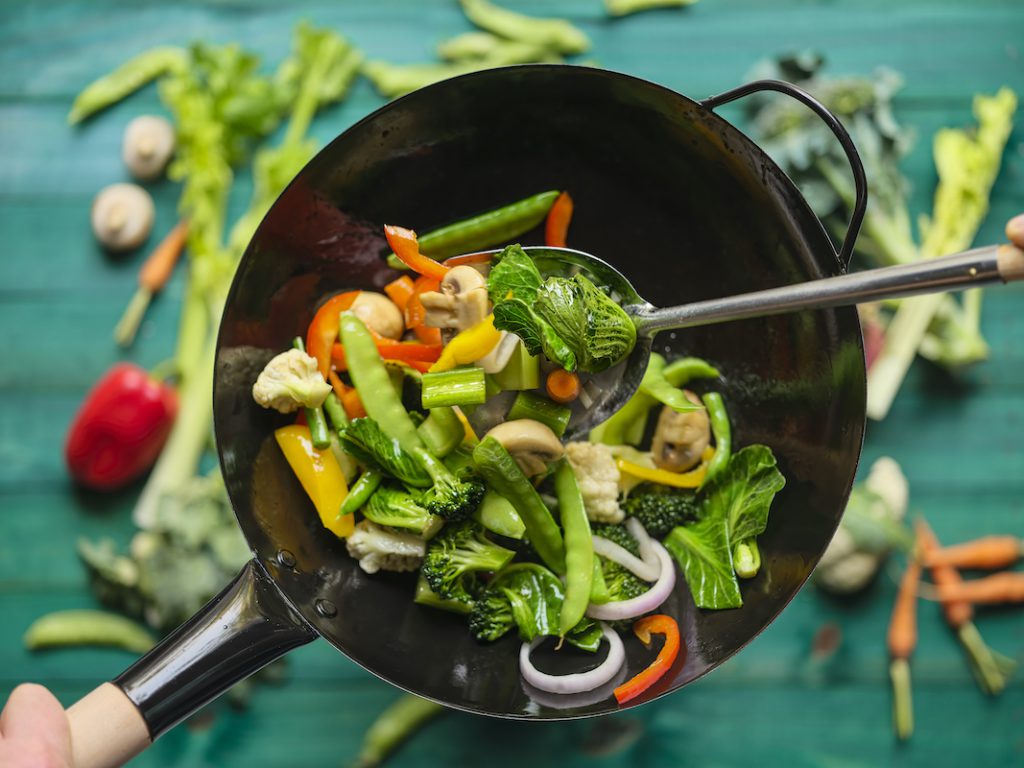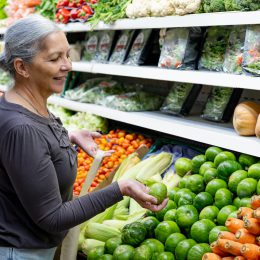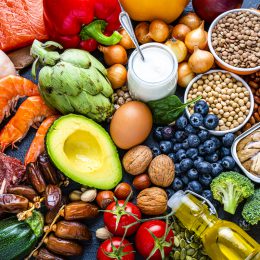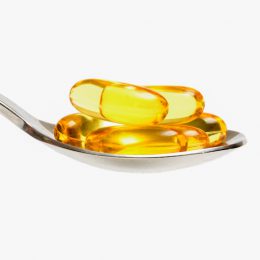3 métodos de cocción saludable que debería usar más a menudo
Maximice los nutrientes de los alimentos, evite la grasa innecesaria y ¡todo con sabor exquisito! Brush up on these expert-approved techniques.

Eating well isn’t just about what you cook — though that’s an excellent start! — it also matters how you cook your ingredients. Some cooking methods do a better job at preserving important nutrients and make it easier to scale back on less-desirable components like saturated fat.
Luckily, you don't need to invest in expensive cookware or be a five-star chef to make healthy meals that taste great. The cooking methods described here best capture the flavor and retain the nutrients in foods to help you get a delicious, good-for-you dinner on the table quickly and without stress.
Healthy Cooking Method #1: Stir-Frying
Lightning-fast cooking at very high heat — that’s the essence of stir-frying. “Stir- frying can be a great way to get a meal cooked quickly,” says Abbie Gellman, R.D., a chef and registered dietitian as well as the author of The Mediterranean DASH Diet Cookbook. And because you only use one pan, there’s also less clean-up.
But even better, stir-frying preserves the texture, flavor, and many of the nutrients of your ingredients. Several research papers, including a recent study in the journal Foods, found that stir-frying can help preserve levels of certain antioxidants in vegetables such as broccoli and kale. Antioxidants can have anti-inflammatory benefits in our bodies and help lower the risk for several chronic conditions such as heart disease.
Top Stir-Frying Tips
Use a flat-bottom wok. This is the ideal pan for stir-frying, as food can be quickly browned in the “belly” of the pan and then tossed around the sloping sides. There’s no need to make a big investment: An inexpensive carbon-steel wok with a wooden handle will get the job done. With plenty of use, it develops a natural non-stick surface, letting you cut back on the amount of oil needed, another healthy-eating bonus. You can also stir-fry in a skillet; make sure to use one that has high sides so that food stays contained.
Prep all your ingredients before you heat the pan. Things happen quickly with stir-frying, so make sure you have all the ingredients you need cut and ready to go ahead of time. This includes having sauces already mixed together. Vegetables and meats should be sliced into small, uniform pieces so they cook quickly and in the same amount of time.
Use quick-cooking proteins. Chicken breast, steak, shrimp, salmon, pork tenderloin, or tofu are ideal for stir-frying. Avoid tough cuts like pork shoulder that benefit from long, slow cooking, or delicate, flaky seafood such as sole or flounder.
Avoid hard, fibrous vegetables. Bell peppers, asparagus, mushrooms, broccoli, zucchini and carrots are all great veggie choices for stir-frying, while beets, potatoes and butternut squash won’t have enough time to cook properly.
Preheat your wok or skillet before adding the oil. Very hot is what you’re going for, says Gellman. When water droplets vaporize on impact with the surface, it’s time. Also important: Use a light hand with the oil. You need just enough to form a thin film on the pan.
Don’t overcrowd the pan. Overcrowding your pan can bring down the heat of the wok, causing your ingredients to steam instead of stir-fry, so cook items in batches if needed. Frequently stir your vegetables with a spatula as they cook.
Work in stages. Start by cooking meats or plant-based proteins. Once cooked, remove meats from the pan and add your vegetables. Start with denser ones like carrots or asparagus and then add delicate items such as leafy greens. Once the vegetables are tender-crisp, add back in your protein along with any seasonings such as sauces and cook for roughly another minute.
Healthy Cooking Method #2: Steaming
If you get plenty of vegetables in your diet, good for you. Now make sure you're getting the most nutrition from them. Steaming is a moist-heat cooking method that "allows for vegetables to be crisp-tender without turning mushy," Gellman says.
Steaming’s pretty simple: Basically, liquid heated to the boiling point turns to vapor (steam), which circulates around the food, transferring energy and heat so the food cooks quickly but delicately. Contrast that with boiling, which involves submerging the vegetables completely, causing some nutrients, like vitamin C and B vitamins, to leach out into the cooking water. A study in the Journal of Agriculture and Food Chemistry found that steaming can boost the antioxidant power of carrots, broccoli and zucchini.
"It turns out some nutrients and antioxidants in vegetables may be better absorbed in our bodies when cooked," notes Gellman. Also, since steaming vegetables doesn't require the use of any cooking fat, you can save on the calories typically added in sautéing, stir-frying, roasting, and frying.
Top Steaming Tips
Dice or cut veggies into uniform pieces first. This tip helps ensure even cooking. Harder vegetables like potatoes, beets, and carrots will require longer steaming times — cutting them smaller can shave off a few minutes.
Steam your proteins, too. Choose quicker-cooking ones like scallops, shrimp, fish fillets and boneless chicken breasts instead of sturdier meats like beef or pork.
Use a metal or plastic collapsible steamer basket placed inside a pot or an Asian-style bamboo steamer on top of a larger pot. Both tools are inexpensive and widely available (there are also plug-in electric steamers available, though they’re pricier). If you use a bamboo steamer, you can place meats on the bottom layer and vegetables on the top layer to streamline the cooking (and the clean-up afterward).
Fill your steaming pot about one-third full with water. Remember, if the food is submerged, you’re boiling it, not steaming it. Place veggies in an even layer; overcrowding results in uneven cooking.
Line the steamer. To prevent sticking when steaming meats and fish, line the steamer with parchment paper or even a layer of cabbage leaves.
Flavor the water. For added flavor, place aromatics such as herbs, citrus peel, garlic and/or ginger in the steaming water.
Leave the lid slightly ajar. Cover the pot to prevent most of the steam from escaping, but leave the lid slightly ajar, which allows acidic compounds to escape. That helps preserve the bright colors of vegetables like broccoli. Check your pot periodically to make sure the water hasn’t all vaporized.
Mind the time. Steam vegetables only to the point where you can pierce them with a fork—they shouldn’t be too soft.
Suscríbase a nuestro boletín informativo
Es rápido y fácil: Usted podría estar entre las 13 millones de personas elegibles.
¿Ya es miembro? Haga clic para descubrir nuestros más de 15,000 centros participantes.
Síganos
Healthy Cooking Method #3: Poaching
It sounds chef-y, but poaching is nothing more than delicately cooking food in liquid. The goal is to keep meats juicy and tender. As they cook, meats release their flavor into the surrounding liquid while simultaneously absorbing the tenderizing liquid in an ongoing back-and-forth process.
Poaching allows the proteins in foods to uncoil, or denature, slowly, without squeezing out moisture. Read: no more rubbery chicken.
Another benefit of poaching is that it’s much less likely to cause the formation of harmful compounds called (hang in there — this is a mouthful!) advanced glycation end products (AGEs). AGEs have been linked with raising the risk for certain cancers and cardiovascular disease. According to research published in the Journal of the Academy of Nutrition and Dietetics, dry-heat cooking meats such as roasting or grilling could create these compounds. Poaching is a much gentler method.
Succulent poached meats can be eaten on their own or used in a wide range of dishes including sandwiches, tacos, and salads. For instance, you can shred your poached chicken and make chicken enchiladas or dice it for a protein boost to salads.
Top Poaching Tips
Add enough liquid. Any large cooking vessel with a lid will work for poaching. Place your meat in the pot or pan and add enough liquid to cover it by about 1 inch.
Flavor the liquid. Your poaching liquid can be as basic as salted water or broth. For a flavor boost, consider adding other liquids like white wine, beer, cider, coconut milk, or tomato juice. Infuse even more flavor by adding aromatics such as onions, shallots, fennel, celery, lemon slices, ginger and herbs to the hot liquid.
Heat the pot until the liquid is simmering, not boiling. When you see a little bit of movement and the rare bubble breaking the surface, you’ve found the sweet spot for poaching. If you have an instant-read thermometer, use it: Ideally, keep the temperature of the poaching liquid to 160–170°F.
Mind the time. Partially cover the pan and poach until meat is cooked through to a safe internal temperature according to these guidelines by the USDA. Chicken breast takes about 15 minutes; a cut of skinless salmon needs roughly 8 minutes. Skim off any foam that forms during cooking.
Save the poaching liquid. Get a start on your next meal: Keep the poaching liquid (remove solids first) and use it as you would broth in recipes such as soups or sauces. It will keep in the refrigerator for up to 5 days or the freezer for several months.
Check Your SilverSneakers Eligibility Instantly!
Los miembros de SilverSneakers pueden ir a miles de gimnasios y centros de fitness en todo el país, además de tomar clases en línea de SilverSneakers EN VIVO que están diseñadas para personas mayores de todos los niveles. Si tiene un plan de Medicare, puede incluir SilverSneakers, sin costo adicional. Verifique su elegibilidad al instante aquí.
¿No es elegible para SilverSneakers? Aun puede recibir más de 200 videos On-Demand de SilverSneakers gratis y mantenerse en contacto con nosotros creando su cuenta en línea.





